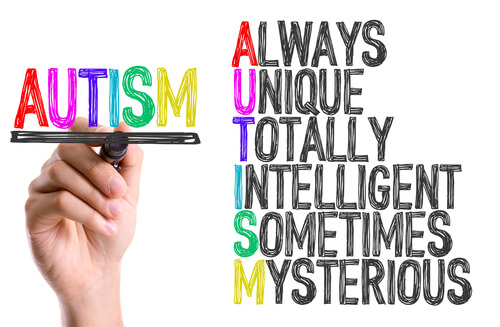Supporting the challenges experienced by individuals with ASD

Individuals with Autism Spectrum Disorder (ASD) can have a variety of challenges within the home and school environment which can impact on their ability to understand what we are communicating to them, for themselves to communicate to us effectively and be best able to learn.
HOW CAN ADULTS SUPPORT INDIVIDUALS WITH ASD?
When the adults around individuals with ASD have a better understanding of some of the needs and characteristics of individuals on the Autism Spectrum these young people can be better supported across home and school settings and work towards more effective outcomes for parents and teachers.
Some of the KEY NEEDS AND CHARACTERISTICS can be summarised to be:
- Being primarily visual learners
- Have Sensory Processing Difficulties
- Having Slower Processing times
- Being Self-taught readers with a focus on pattern recognition
- Have a ‘one track mind’
- Appear ‘allergic to mistakes’
- Struggling to implement strategies learnt when emotional
These needs and characteristics will be further discussed along with strategies to work towards implementing to support individual with ASD when these needs and characteristics present challenges within the home and school settings.
ASSISTANCE IN COMMUNICATION
Research and literature have highlighted that individuals with ASD cope more effectively and learn more readily when provided with visual input collaboratively with verbal inputs (Hodgdon, 1991; Quill, 1997; Schuler, 1995). Ensuring that this is kept front and centre of our interactions with an individual with ASD can therefore be a powerful asset.
To assist effective communication, learning and retention we can employ the use of strategies to make our communication more visual by providing demonstrations, providing visual timelines and schedules, providing photos and videos of someone else completing the tasks first in addition to providing clear body language and gestures such as pointing and simple sign language.
ASSISTANCE IN MANAGING SENSORY INPUTS
Due to sensory processing difficulties, individuals with ASD can often have difficulties processing verbal or auditory information. They can have difficulty differentiating a voice from the sounds around them in the environment and struggle to stay focused on what someone is saying when they are in a noisy or sensory stimulating environment.
Being aware of this we can support these individuals by trying to providing a quiet and calm environment, reduce unnecessary auditory inputs (eg: turn off music or tv, close windows, dim lights etc). Try to be close to the individual and give them 1:1 instructions, at home this might look like not yelling instructions across the room, and in the school setting it may look like allowing the student to sit closer to the teacher. In addition to this pairing auditory instruction with visuals as described above can also assist processing.
ASSISTANCE IN PROCESSING INFORMATION
It is well understood in literature that individuals with ASD typically need more processing time that their peers. This being because they need to process the verbal instructions, process any non-verbal cues which is often a slower and more cognitive process and then determine an appropriate response (Hodgdon, 1991; Prizant et al, 2006). Appreciating the challenge of this when also considering the sensory processing difficulties previously mentioned and the tendency to be drawn to patterns or focus on small details rather than the big picture, it is no wonder that processing takes longer!
When an individual is not given adequate opportunity and time to process all this they may simply learn to respond with “I don’t know” and be left feeling anxious or frustrated at themselves. These individuals will greatly benefit from being given adequate time to process information, which means we may be left waiting a bit longer than we might like to. Rather than trying to restate the question or answer it for them, it may be helpful to simply ask “Still thinking or stuck?” to give them the opportunity to answer. In addition to this giving the individual simple instructions, avoiding abstract ideas in communication and focusing on giving them one step to focus on at a time can reduce the amount that they need to process at once.
ASSISTANCE IN LEARNING
It is not unusual for individuals with ASD to be self-taught readers, appearing highly intelligent at a young age and to have good reading accuracy. This skill can develop due to their skills at noticing and observing patterns. Despite this skill they can however struggle with the comprehension of what they are reading and in being able to communicate this in a meaningful way which may baffle or confuse the adults around them.
Within homework time at home or during classes at school providing students with a scaffold of key information to collect to extract meaning from reading tasks may assist them in strengthening their comprehension. Eg: in a simple form asking them the basics of who, what, where, when and why (although depending on their age they may require support to explore the why).
ASSISTANCE IN MANAGING INFLEXIBILITY
It is well known that individuals with ASD can have a ‘one track mind’ preferring to focus on their own interests and agenda, struggling to take advice or guidance from others and have difficulties transitioning tasks. Some strategies to overcome this can be to provide the individual with supports such as a timer to indicate how long they have left on undesirable tasks or until they get to engage with a desired task.
In addition to this stating a clear goal before starting the task to ensure that the individual is aware of when the task will end can assist them to participate (eg: We will complete 5 Maths questions or we will draw 10 shapes) (Blome, 2018). Providing individuals the opportunity to incorporate their special interest into learning activities may also assist them to be more motivated and engaged in the learning or home based tasks.
ASSISTANCE IN COPING WITH MISTAKES
Individuals with ASD can appear to fear making mistakes, or more dramatically seem ‘allergic to mistakes’ (Attwood, 2019). This can be due to concerns of looking silly and seeing the mistakes as evidence that they are silly. This can lead to behaviours such as avoiding answering questions or completing work to avoid these outcomes. At the other end of the spectrum we can see the individual not backing down even when they are clearly incorrect, the need to be right ‘all the time’ and pointing out others errors to demonstrate their own intelligence. This can arise because the individual may student may perceive themselves as being more like the parent/teacher than a kid/student, difficulties coping emotionally with the feelings that arise when making mistakes and poor cognitive flexibility.
Strategies we can use in these situations is to avoid escalating into arguments as the adults by deciding to stop the discussion regardless of who is ‘right’, providing an environment where mistakes are acknowledged as opportunities to learn and grow and having adults and teachers model making mistakes and coping with these calmly or admitting they made a mistake. Given the preference for learning visually seeing such modelling may assist them to learn more effectively how to cope in these situations when making mistakes and become more ok with making and admitting mistakes.
ASSISTANCE IN EMOTIONAL REGULATION
Finally, every human being has trouble thinking logically and rationally when they are in an emotionally charged state, this is no different for individual with ASD. Individuals with ASD may often have difficulties in thinking rationally when in a heightened emotional state. Despite learning certain different information or skills there will be difficulties accessing this learnt information (including calming routines) when they are emotional due to the ‘emotional brain high jacking the whole brain’ and metaphorically locking access to those strategies.
In situations where one is highly emotional it is important to focus first and foremost on assist the person to calm down. This can be done by reducing unnecessary sensory inputs including providing limited verbal input and ensuring that the individual is safe and not at risk of endangering themselves or others. As the adult firstly model and use calming routines previously learnt allowing the individual to hopefully watch and observe, this may look like squishy sensory putty or doing deep breathing exercises. With this visual reminder the individual may be aided to recall their calming routines and begin to join in. Calming down the mind and body needs to occur before mentioning or directing back to the triggering event or providing additional verbal inputs.
In summary, individuals with ASD do present with a range of needs and characteristics that can make communicating with them and supporting their learning more challenging. Despite this however there are a range of strategies that can be implemented that can positively impact our interactions and relationships with and better understand young people with ASD.
Hopefully some of these adaptions may support the opportunity to LEARN, GROW and REGULATE themselves within the home and school settings for individuals with ASD.
Written by: Ms. Amanda Kenyon, Senior Registered Psychologist at ACPC Psychology. Amanda is a registered psychologist who works with many children and teens with autism spectrum disorders and other presentations.
References:
Attwood, T. (2019) Understanding Autism Spectrum Disorder: A Different Way of Thinking, Learning and managing students with Autism Spectrum Disorder workshop.
Blome, L. (2018) Practical Strategies for supporting emotional regulation in students with Autism: Enhancing Engagement and learning in the classroom. Jessica Kingsley Publishers.
Hodgdon, L. (1991) Solving behaviour problems through better communication strategies. Autism Society of America Conference Proceedings. Indianapolis.



